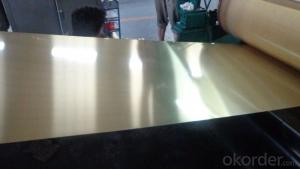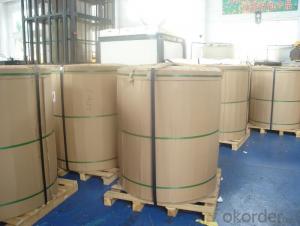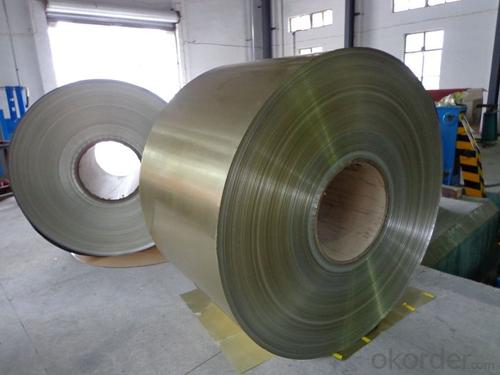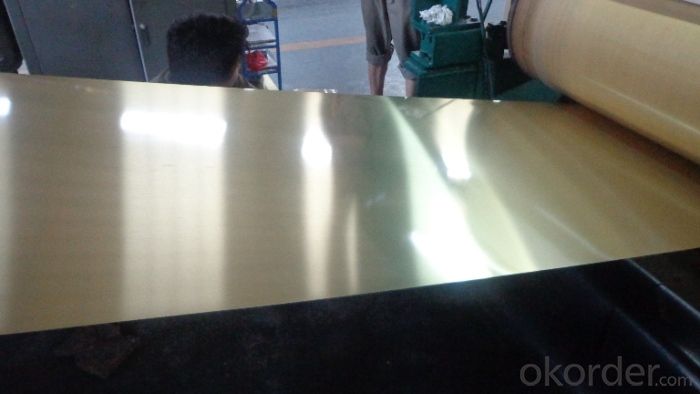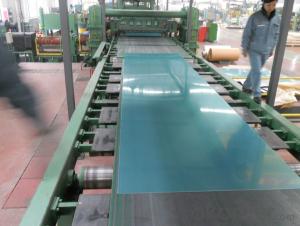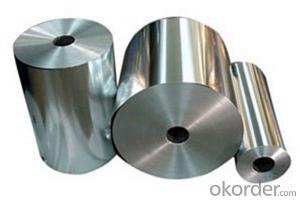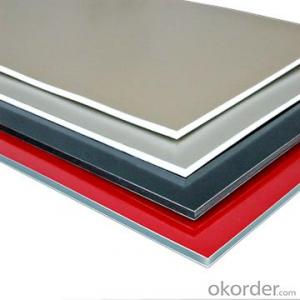Coated Aluminum Coils for Beverage Can Stock
- Loading Port:
- Shekou
- Payment Terms:
- TT OR LC
- Min Order Qty:
- 7 m.t.
- Supply Capability:
- 100000 m.t./month
OKorder Service Pledge
OKorder Financial Service
You Might Also Like
1.Structure of Coated Aluminum Coils for Beverage Can Stock
Our coated aluminium coils are widely used in beverage can stock, such as can ends, can lids, can tabs, aluminium easy-can-cover and ring-pull, etc.
We normally use 5052 H19; 5052, H36; 5182 H19; 5182 H48, 5182 H49 as base coils. Based on ordinary aluminum, we add Mn and Mg, so as to increase tensile strength and elongation.
As for coating, we normal coat gold color for lids, red, blue, etc for tabs. We also can adjust coating according to color of customers and offer personalized services.
We use large wave shear, transverse shear and longitudinal cut system so as to meet different specifications of customers.
2. Main Features of Coated Aluminum Coils for Beverage Can Stock
• Light Weight
• High Flatness
• Good Weathering
• Colorful
• Recycling
• Saving Energy
• Rustproof
3. Coated Aluminum Coils for Beverage Can Stock Images
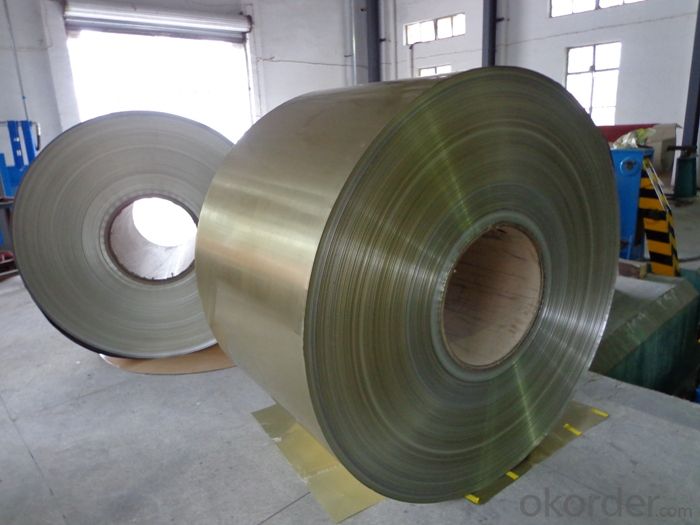


4. Specification of Coated Aluminum Coils for Beverage Can Stock
ALLOY | TEMPER | THICKNESS | WIDTH | COIL OR LENGTH |
5052 5182 | H19 H36 H48 H49 | 0.22-0.5mm | 500-1600mm | AS PER YOUR REQUIREMENTS |
A.What about inspections to guarantee quality?
For each order, we will arrange strict inspection for raw materials, inspection during production and inspection for finished goods.
With requirement of customers, we also can arrange the third party inspection.
B.What about delivery?
We will put order in production schedule after order gets confirmed against copy of TT or L/C. Normally it takes about one month for production. Exact shipment schedule is different based on different sizes and quantity.
C.What is the MOQ?
5 tons for each size.
D. Where have you exported?
We have exported to many countries. Main markets include South East Asia, Middle East, North America, South America, etc.
- Q:Are aluminum coils more expensive than other coil materials?
- It depends on the specific material being compared. Generally, aluminum coils tend to be more expensive than some other coil materials, such as copper or steel. However, the cost can vary depending on factors like the coil size, thickness, and supplier.
- Q:What are the common transportation methods for aluminum coils?
- Aluminum coils can be transported using various methods such as trucking, rail, and shipping. When prompt delivery or short distances are involved, trucking is commonly employed. To ensure secure transit, aluminum coils are loaded onto specialized trailers equipped with cradles or coil racks. This approach provides flexibility and easy access to different locations. For long-distance shipments, rail transportation is frequently utilized. Railcars specifically designed to accommodate the weight and dimensions of aluminum coils are used for loading. This transportation method is advantageous due to its cost-effectiveness and ability to transport large quantities of coils in a single shipment. When it comes to international shipments, shipping by sea is a popular choice. Aluminum coils can be loaded onto cargo ships either in specialized containers or directly on the ship's deck. Shipping offers the benefit of transporting large volumes of coils over long distances and is often preferred for global distribution due to its efficiency and cost-effectiveness. Ultimately, the choice of transportation method for aluminum coils depends on factors such as distance, urgency, quantity, and destination. Companies must carefully consider these factors in order to determine the most suitable transportation method for their specific needs.
- Q:How do aluminum coils contribute to increased structural stability?
- Aluminum coils contribute to increased structural stability in several ways. Firstly, aluminum as a material is highly durable and has excellent strength-to-weight ratio. This means that even though aluminum coils are lightweight, they offer superior strength and stability, making them an ideal choice for structural applications. Additionally, aluminum coils are corrosion-resistant, which is crucial for maintaining structural integrity over time. Unlike other metals, aluminum does not rust or deteriorate easily, even in harsh environmental conditions. This corrosion resistance ensures that the coils will remain structurally sound and reliable for extended periods. Moreover, aluminum coils have high thermal conductivity, which allows for efficient heat transfer. This characteristic is essential for structures exposed to temperature variations, as it helps to distribute and dissipate heat evenly, preventing any potential damage due to thermal expansion or contraction. Another significant advantage of aluminum coils is their flexibility. Aluminum is a malleable material that can be easily bent, shaped, and formed into various configurations. This flexibility allows for more intricate designs and enables the coils to adapt to different structural requirements, enhancing overall stability. Furthermore, aluminum is a non-combustible material, making it a safe choice for structural applications. In the event of a fire, aluminum coils will not contribute to the spread of flames, thus maintaining the integrity of the structure and ensuring the safety of occupants. In conclusion, aluminum coils contribute to increased structural stability through their durability, corrosion resistance, thermal conductivity, flexibility, and fire-resistant properties. These characteristics make them a reliable and efficient choice for a wide range of structural applications, providing long-lasting stability and safety.
- Q:Are there any health concerns associated with aluminum coils?
- Aluminum coils, commonly used in HVAC systems and refrigerators, have been a subject of health concerns due to the possible release of aluminum particles into the air or food. However, studies have consistently shown that the amount of aluminum released from these coils is typically very low, posing no significant health risks. Although aluminum is known to be a neurotoxin, exposure to aluminum coils generally remains well below the harmful threshold. The World Health Organization (WHO) has established a provisional tolerable weekly intake for aluminum, and the amount released from aluminum coils is significantly below this level. It is important to acknowledge that individuals with certain health conditions, such as kidney disease or aluminum sensitivity, may be more vulnerable to the potential health effects of aluminum exposure. In such cases, seeking advice from a healthcare professional or an HVAC specialist is advisable to determine the most appropriate course of action. In summary, while there are some health concerns associated with aluminum coils, they are generally considered minimal and unlikely to pose significant risks to the general population. Proper maintenance and installation of HVAC systems can effectively minimize any potential risks and ensure the safe and efficient operation of aluminum coils.
- Q:Can aluminum coils be painted?
- Indeed, it is possible to paint aluminum coils. By applying paint to aluminum coils, an extra layer of protection against corrosion can be achieved, along with an improvement in their aesthetic appearance. Nevertheless, it is crucial to properly prepare the surface prior to painting in order to ensure a strong adhesion and durability. This typically involves a thorough cleaning of the coils, the removal of any existing paint or coatings, and the application of a primer specifically designed for aluminum surfaces. Once the primer has dried, a suitable paint can be applied using a brush, roller, or spray. For optimal and long-lasting results, it is advisable to use a high-quality paint specially formulated for metal surfaces. Additionally, following the instructions provided by the manufacturer and taking into account any environmental factors, such as temperature and humidity, that could impact the painting process, is of utmost importance.
- Q:Are aluminum coils suitable for architectural roofing systems?
- Yes, aluminum coils are suitable for architectural roofing systems. Aluminum is a popular choice for roofing due to its numerous advantages. Firstly, aluminum is lightweight, which makes it easier to handle during installation and reduces the load on the building's structure. Additionally, aluminum is highly durable and corrosion-resistant, making it a long-lasting option for architectural roofing systems. It also has excellent thermal properties, reflecting heat and reducing energy consumption. Moreover, aluminum coils can be easily shaped and formed into various profiles and designs, allowing for flexibility in architectural styles. Lastly, aluminum is a sustainable material as it is recyclable, making it an environmentally friendly choice for roofing systems. Overall, aluminum coils are a suitable and practical option for architectural roofing systems, providing durability, versatility, and energy efficiency.
- Q:What are the different coil annealing options available for aluminum coils?
- There are several coil annealing options available for aluminum coils, depending on the desired outcome and requirements. 1. Full Annealing: This is a process where the aluminum coil is heated to a specific temperature and then slowly cooled down. Full annealing helps to relieve internal stresses, improve ductility, and enhance the mechanical properties of the coil. It also results in a soft and fully recrystallized structure. 2. Solution Annealing: Solution annealing is primarily used for heat-treatable aluminum alloys. It involves heating the coil to a temperature above the alloy's solvus temperature, followed by rapid cooling. This process helps dissolve and redistribute any alloying elements, resulting in a homogenous microstructure. 3. Stabilization Annealing: Stabilization annealing is performed on certain aluminum alloys to enhance their dimensional stability and reduce the risk of distortion during subsequent processing or usage. It involves heating the coil to a temperature just below the alloy's recrystallization temperature and then slowly cooling it. 4. Stress Relief Annealing: This type of annealing is performed to relieve residual stresses that may have developed during previous manufacturing processes, such as rolling or stretching. The coil is heated to a specific temperature and held there for a certain duration, allowing the stresses to relax. It helps to improve the coil's formability and minimize the risk of deformation during subsequent operations. 5. Intermediate Annealing: Intermediate annealing is performed during the manufacturing process to restore the ductility and formability of the aluminum coil. It involves heating the coil to a temperature below the recrystallization temperature, followed by a controlled cooling process. This helps to eliminate work hardening that may have occurred during previous operations. These are some of the common coil annealing options available for aluminum coils. The specific choice depends on factors such as the alloy composition, intended application, and desired material properties. It is important to consult with experts or heat treatment professionals to determine the most suitable annealing method for a particular aluminum coil.
- Q:Are aluminum coils resistant to saltwater corrosion?
- Yes, aluminum coils are resistant to saltwater corrosion.
- Q:What are the common recycling methods for aluminum coils?
- Aluminum coils can be recycled using various methods. Mechanical recycling is a commonly employed technique. It entails shredding the coils into small pieces and then melting them to create new coils. This method is both efficient and cost-effective, as it maintains the quality of the aluminum material while allowing for its reuse. Pyrolysis is another method used for aluminum coil recycling. It involves heating the coils at high temperatures in the absence of oxygen. This process breaks down the aluminum into its constituent elements, enabling the recovery of valuable metals and other byproducts. Chemical recycling is an alternative approach for recycling aluminum coils. It involves dissolving the coils in a chemical solution to separate the aluminum from other materials. The resulting aluminum can then be utilized to manufacture new coils. Lastly, smelting is a method that can be employed for aluminum coil recycling. It revolves around melting the coils and separating impurities through electrolysis. This method facilitates the recovery of pure aluminum, which can be utilized in the production of new coils. In summary, these recycling methods play a pivotal role in reducing the environmental impact of aluminum coil production. They conserve resources, minimize waste, and promote the sustainability of the aluminum industry by encouraging the reuse of materials and decreasing the need for new aluminum production.
- Q:What is the typical coil diameter for aluminum coils?
- The typical coil diameter for aluminum coils can vary depending on the specific application and industry, but it is generally in the range of 12 to 72 inches.
1. Manufacturer Overview |
|
|---|---|
| Location | |
| Year Established | |
| Annual Output Value | |
| Main Markets | |
| Company Certifications | |
2. Manufacturer Certificates |
|
|---|---|
| a) Certification Name | |
| Range | |
| Reference | |
| Validity Period | |
3. Manufacturer Capability |
|
|---|---|
| a)Trade Capacity | |
| Nearest Port | |
| Export Percentage | |
| No.of Employees in Trade Department | |
| Language Spoken: | |
| b)Factory Information | |
| Factory Size: | |
| No. of Production Lines | |
| Contract Manufacturing | |
| Product Price Range | |
Send your message to us
Coated Aluminum Coils for Beverage Can Stock
- Loading Port:
- Shekou
- Payment Terms:
- TT OR LC
- Min Order Qty:
- 7 m.t.
- Supply Capability:
- 100000 m.t./month
OKorder Service Pledge
OKorder Financial Service
Similar products
New products
Hot products
Hot Searches
Related keywords

